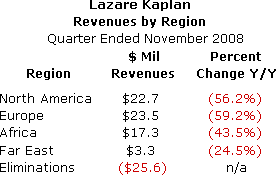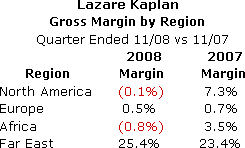IDEX Online Research: Lazare Kaplan Loses Sales, Profits and Litigation
February 03, 09
Like most diamond and jewelry suppliers, Lazare Kaplan is feeling the impact of the global economic slowdown. Sales are down dramatically, and profits have evaporated. All of this was reported in the company’s recent press release for the quarter ended November 2008.
In addition, Lazare Kaplan appears to have lost its court case related to the protection of its intellectual property rights.
Finally, an analysis of the company’s performance – sales and profits – by market reveals that the Far East is the company’s least-affected market in the current weak economic environment. However, this market represents only about 8 percent of the company’s sales.
Lazare Kaplan’s Broad Overview of the Quarter
Here is a direct quote from the company’s legal filing:
“The financial market crisis and economic downturn has disrupted credit and equity markets worldwide and led to deterioration in the global economic environment, a general tightening of credit, lower levels of liquidity and discretionary spending, and increases in the rates of default and bankruptcy.”
“During the fiscal quarter ended November 30, 2008 rough and polished diamond sales slowed significantly as customers focused on selling owned inventory and preserving liquidity in response to the global economic downturn. As a result, some diamond producers have reduced mining activity or begun to stockpile inventory.”
“In the current economic environment, some of the Company’s customers may experience difficulty in paying for previously purchased products.”
An analysis of Lazare Kaplan’s legal filings yields not only a detailed analysis of Lazare Kaplan’s operations, but it also yields some broad trends which likely affect other privately held suppliers who do not disclose the details of their operations.
Quarterly Highlights
Here are some of the highlights of the factors affecting Lazare Kaplan’s operations, based on an analysis of the company’s financial results for the quarter ended November 2008.

- Revenues declined by 54 percent from the same quarter a year ago. In other words, Lazare Kaplan’s revenues dropped by more than half from the prior year’s quarter, both for polished and rough diamonds. That’s a dramatic decline by any measure.
- Sales of polished diamonds dropped by 53 percent to $20.2 million. The sales decline reflects lower demand for both branded diamonds and fine cut commercial diamonds. Management noted that polished diamond sales have been significantly affected by weak economic conditions as well as the reluctance of customers to add to their inventories primarily due to liquidity and credit concerns.
- Sales of rough diamonds declined by 56 percent to $21.1 million. Lower revenues from rough diamond sales reflect reduced sourcing activities by Lazare Kaplan as it sought to preserve liquidity as well as its reluctance to purchase rough diamonds in what management considered over-priced in the current market.
- Sales trends by geographic area are summarized on the following table. (“Eliminations” represent goods which may have been shifted between regions and were therefore double-counted.)

Source: Lazare Kaplan
- Gross margins were under siege in the three-month period ended November 2008. Lazare Kaplan’s corporate gross margin was only 1.7 percent of sales, down dramatically from last year’s 7.0 percent. In the early part of the decade, Lazare Kaplan’s annual gross margin was in the 11-12 percent range, but it softened to the mid-to-high single level over the past few years. Thus, the current gross margin level of 1.7 percent is dramatically below the company’s long term trend level.
- Lazare Kaplan posted a gross margin of 6.5 percent on its polished diamond sales, down significantly from last year’s 9.5 percent. This reduced margin level is due to lower margins on virtually all of the company’s product lines resulting from the liquidation of slower moving goods, the expensing of certain overhead costs, and credits issued in connections with the return of certain inventory.
- The company’s gross margin on its rough diamond sales was a negative (3.0 percent), down substantially from the prior year’s 4.8 percent. In other words, the company lost money trading rough diamonds. We think this may characterize many other smaller rough diamond traders; Lazare Kaplan posted revenues from rough diamond sales of just over $21 million in the quarter.
The decline in gross margin on rough diamond sales reflects trading losses incurred by falling demand which pushed down prices for rough stones. In addition, the rough diamond margin reflects the expensing of unabsorbed sourcing costs associated with the company’s informal sector rough buying operation. Since Lazare Kaplan is not a major player in the rough diamond sector, the company must play around the edges.
- The following table summarizes gross margins by geographic region.
 Source: Lazare Kaplan |
- The company posted a pretax loss of $5.9 million versus last year’s profit of $400,000. In addition, the company had a profit of $1.6 million for its quarter ended August 2008. Clearly, profitability deteriorated dramatically in the November quarter.
- Lazare Kaplan’s ability to fund its operations appears to be intact, according to management. A legal filing in mid-January 2009 states, “the company believes it has the ability to meet its anticipated financing needs for at least the next twelve months.” Both Leon Tempelsman, the company’s president and CEO, as well as Bill Moryto, the company’s vice president and CFO, signed a statement certifying that the legal documents – including the claim that the company has adequate financing – present a reasonable view of the company.
- For several years, the company has adamantly stated that it would aggressively protect its intellectual property rights and patents. In mid-2006, it filed an infringement suit against Photoscribe, and later added the GIA, related to equipment and methods for laser inscribing diamonds.
In March 2008, a jury said that all but one of Lazare Kaplan’s infringement claims were valid. But, the jury also said that the defendants – Photoscribe and the GIA – did not infringe on the patents. However, prior to the conclusion of the trial, the parties settled most of their contract claims.
Further, at a trial in April and May 2008, the court determined that Lazare Kaplan’s patents related to the suit were unenforceable for inequitable conduct.
On January 5, 2009, the court approved an agreement between the parties that dropped the remaining contract dispute and ordered Lazare Kaplan to pay attorneys’ fees and costs to the GIA and Photoscribe for $6.3 million.
Lazare Kaplan management plans to appeal the verdicts related both to the finding that its patents are unenforceable due to inequitable conduct as well as the court’s order to pay attorneys’ fees.
In short, stay tuned. This squabble isn’t over yet.
- After two and a half years, the company remains in litigation with Fifth Avenue Group, which at one time included principals of M. Fabrikant & Co. (and may still include those principals, but recent information is not available), about the ability of Fifth Avenue Group to vote and perhaps monitize about 1.2 million LKI (Lazare Kaplan International) shares it owns. The company did not disclose any new information about the status of this lawsuit.
- For many years, Lazare Kaplan has been selling treated diamonds under the Bellataire brand name. Its wholly-owned subsidiary, Pegasus Overseas has an exclusive marketing agreement with Diamond Innovations, the current supplier of the treated stones. Since GE sold off this division several years ago, there has been a succession of owners. In Lazare Kaplan’s most recent legal filing, it notes that it has this agreement through February 2009. In short, the agreement with Diamond Innovations appears to be on the verge of expiration, but Lazare Kaplan management did not provide any update about the potential extension of the marketing agreement.
Our industry sources tell us that the Bellataire diamonds have never been a major factor in the industry, and that sales are miniscule. Lazare Kaplan does not disclose sales of Pegasus Overseas or the Bellataire brand.